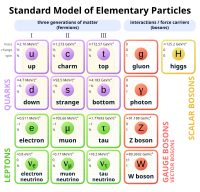
Photo from wikipedia
Far infrared fine-structure transitions of CI and CII and rotational transitions of CO are used to probe hypothetical variations of the electron-to-proton mass ratio mu = m_e/m_p at the epoch… Click to show full abstract
Far infrared fine-structure transitions of CI and CII and rotational transitions of CO are used to probe hypothetical variations of the electron-to-proton mass ratio mu = m_e/m_p at the epoch of reionization (z > 6). A constraint on Delta mu/mu = (mu_obs - mu_lab)/mu_lab = (0.7 +/- 1.2)x10^-5 (1sigma) obtained at = 6.31 is the most stringent up-to-date limit on the variation of mu at such high redshift. For all available estimates of Delta mu/mu ranging between z = 0 and z = 1100, - the epoch of recombination, - a regression curve Delta mu/mu = k_mu (1+z)^p, with k_mu = (1.6 +/- 0.3) x10^-8 and p = 2.00 +/- 0.03, is deduced. If confirmed, this would imply a dynamical nature of dark matter/dark energy.
Journal Title: Monthly Notices of the Royal Astronomical Society
Year Published: 2020
Link to full text (if available)
Share on Social Media: Sign Up to like & get
recommendations!